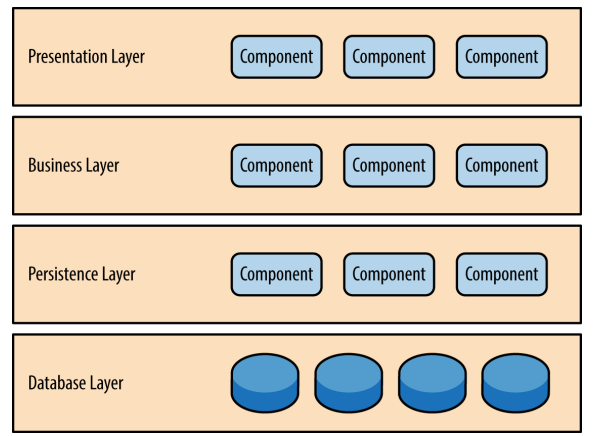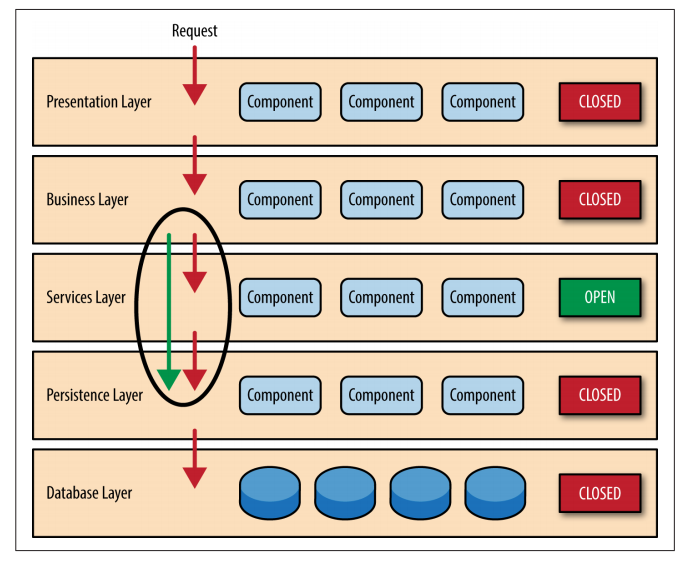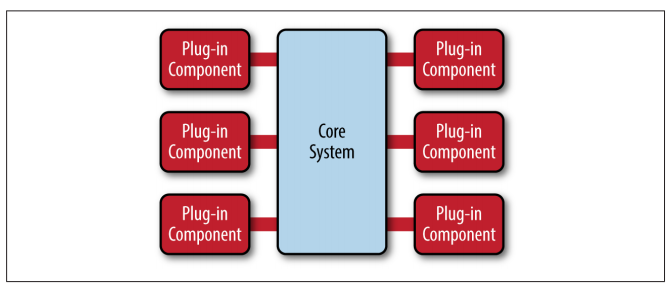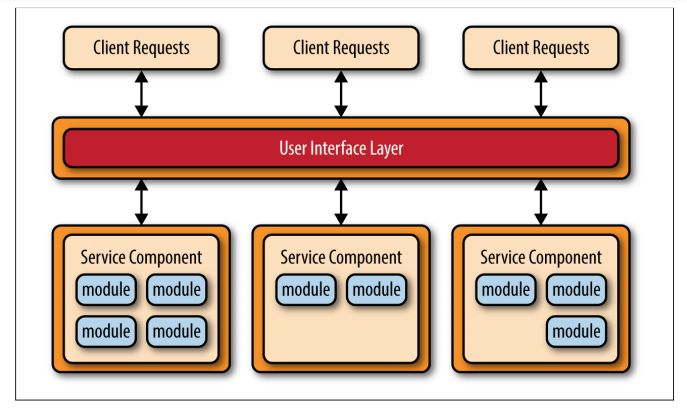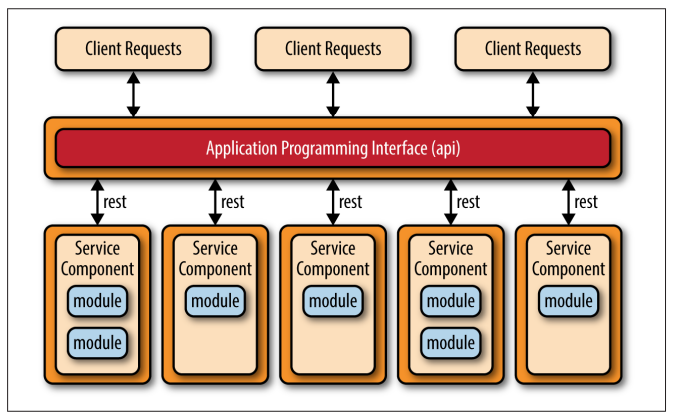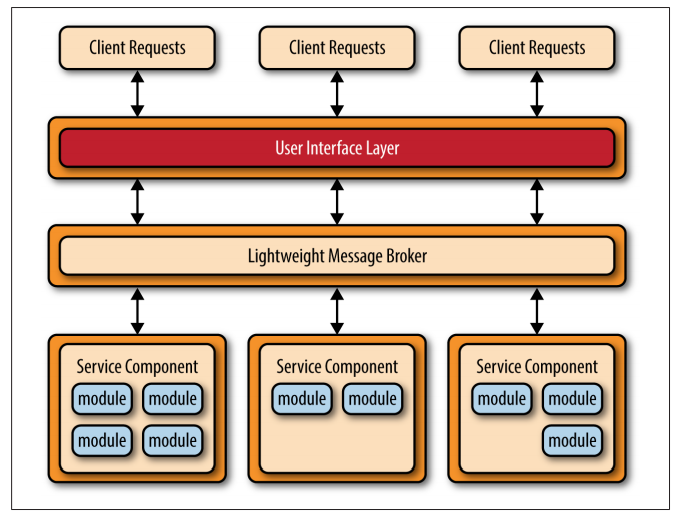Requirements
Function Requirements
These are your use-cases. For example, for a e-commerce site, you may need to offer functionality like: search inventory, place order and review past orders.
Non-Functional Requirements
How should the system behave.
These are requirements like:
- usability
- reliability
- efficiency
- scalability
- maintainability
Restrictions
Restrictions limit your options.
Restrictions include:
- compliance
- costs
- standards
- time to market
Priorities
We need to prioritize functional and non-functional requirements based on restrictions.
For example: may not prioritize portability if we control where the solution is to be deployed.
Implementation
Key Concepts
- Start with one thing at a time.
- Keep it simple. (KISS)
- Don't over engineer. You ain't gonna need it. (YAGNI)
Software Architecture Patterns
See O'Reillys - Software Architecture Patterns
Layered Architecture Pattern
Components within the layered architecture pattern are organized into horizontal layers, each layer performing a specific role within the application (e.g., presentation logic or business logic). Although the layered architecture pattern does not specify the number and types of layers that must exist in the pattern, most layered architec‐ tures consist of four standard layers: presentation, business, persistence, and database.
A request originating from the presentation layer must first go through the business layer and then to the persistence layer before finally hitting the database layer.
While closed layers facilitate layers of isolation and therefore help isolate change within the architecture, there are times when it makes sense for certain layers to be open. For example, suppose you want to add a shared-services layer to an architecture containing com‐ mon service components accessed by components within the busi‐ ness layer (e.g., data and string utility classes or auditing and logging classes). Creating a services layer is usually a good idea in this case because architecturally it restricts access to the shared services to the business layer (and not the presentation layer). Without a separate layer, there is nothing architecturally that restricts the presentation layer from accessing these common services, making it difficult to govern this access restriction.
Pattern Analysis
Overall agility Rating: Low Analysis: Overall agility is the ability to respond quickly to a constantly changing environment. While change can be isolated through the layers of isolation feature of this pattern, it is still cumbersome and time-consuming to make changes in this architecture pattern because of the monolithic nature of most implementations as well as the tight coupling of components usually found with this pattern.
Ease of deployment Rating: Low Analysis: Depending on how you implement this pattern, deployment can become an issue, particularly for larger applica‐ tions. One small change to a component can require a redeployment of the entire application (or a large portion of the application), resulting in deployments that need to be planned, scheduled, and executed during off-hours or on weekends. As such, this pattern does not easily lend itself toward a contin‐ uous delivery pipeline, further reducing the overall rating for deployment.
Performance Rating: Low Analysis: While it is true some layered architectures can per‐ form well, the pattern does not lend itself to high-performance applications due to the inefficiencies of having to go through multiple layers of the architecture to fulfill a business request.
Scalability Rating: Low Analysis: Because of the trend toward tightly coupled and mon‐ olithic implementations of this pattern, applications build using this architecture pattern are generally difficult to scale. You can scale a layered architecture by splitting the layers into separate physical deployments or replicating the entire application into multiple nodes, but overall the granularity is too broad, making it expensive to scale.
Event Driven Architecture
The event-driven architecture pattern is a popular distributed asynchronous architecture pattern used to produce highly scalable applications. It is also highly adaptable and can be used for small applications and as well as large, complex ones. The event-driven architecture is made up of highly decoupled, single-purpose event processing components that asynchronously receive and process events.
Microkernal/Plug-In Architecture
The microkernel architecture pattern (sometimes referred to as the plug-in architecture pattern) is a natural pattern for implementing product-based applications. A product-based application is one that is packaged and made available for download in versions as a typical third-party product
The microkernel architecture pattern allows you to add additional application features as plug-ins to the core application, providing extensibility as well as feature sep‐ aration and isolation.
The core system needs to know about which plug-in modules are available and how to get to them. One common way of implementing this is through some sort of plug-in registry. This registry contains information about each plug-in module, including things like its name, data contract, and remote access protocol details (depending on how the plug-in is connected to the core system).
Plug-in modules can be connected to the core system through a variety of ways, including OSGi (open service gateway initiative), messaging, web services, or even direct point-to-point binding (i.e., object instantiation).
Example: Perhaps the best example of the microkernel architecture is the Eclipse IDE. Downloading the basic Eclipse product provides you little more than a fancy editor. However, once you start adding plug-ins, it becomes a highly customizable and useful product.
Considerations
Scalability Rating: Low Analysis: Because most microkernel architecture implementa‐ tions are product based and are generally smaller in size, they are implemented as single units and hence not highly scalable. Depending on how you implement the plug-in modules, you can sometimes provide scalability at the plug-in feature level, but overall this pattern is not known for producing highly scala‐ ble applications.
Ease of development Rating: Low Analysis: The microkernel architecture requires thoughtful design and contract governance, making it rather complex to implement. Contract versioning, internal plug-in registries, plug-in granularity, and the wide choices available for plug-in connectivity all contribute to the complexity involved with implementing this pattern.
MicroServices Architecture
Core Concepts
- separately deployed units
- distributed architecture, meaning that all the components within the architecture are fully decoupled from one other and accessed through some sort of remote access protocol (e.g., JMS, AMQP, REST, SOAP, RMI, etc.)
Service components contain one or more modules (e.g., Java classes) that represent either 27 a single-purpose function (e.g., providing the weather for a specific city or town) or an independent portion of a large business application (e.g., stock trade placement or determining auto-insurance rates). Designing the right level of service component granularity is one of the biggest challenges within a microservices architecture.
Api - REST Based Topology
The API REST-based topology is useful for websites that expose small, self-contained individual services through some sort of API (application programming interface).
Centralized Messaging Topology
Another common approach within the microservices architecture pattern is the centralized messaging topology. This topology (illus‐ trated in Figure 4-4) is similar to the previous application RESTbased topology except that instead of using REST for remote access, this topology uses a lightweight centralized message broker (e.g., ActiveMQ, HornetQ, etc.). It is vitally important when looking at this topology not to confuse it with the service-oriented architecture pattern or consider it “SOA-Lite." The lightweight message broker found in this topology does not perform any orchestration, transfor‐ mation, or complex routing; rather, it is just a lightweight transport to access remote service components.
Considerations
Performance Rating: Low Analysis: While you can create applications implemented from this pattern that perform very well, overall this pattern does not naturally lend itself to high-performance applications due to the distributed nature of the microservices architecture pattern.
Space-Based Architecture
References
| Reference | URL |
|---|---|
| Software Architecture Patterns | https://github.com/gg-daddy/ebooks/blob/master/software-architecture-patterns.pdf |
